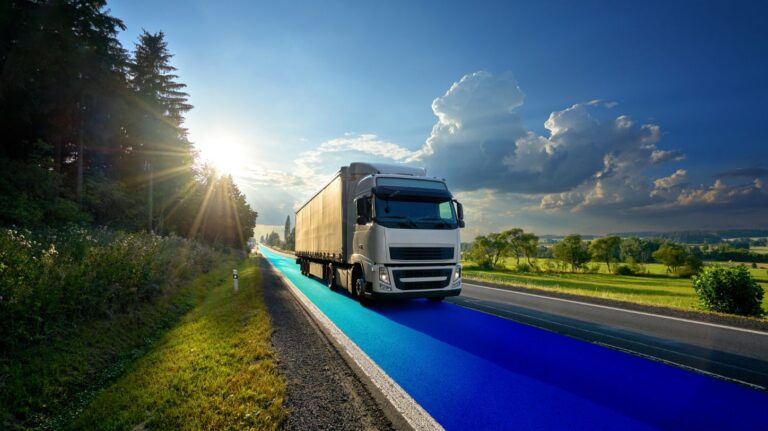Giles Benbow, senior manager for business and partnership development at Mer, considers why electrifying commercial and heavy goods vehicles (HGVs) is crucial for the net zero transition and the challenges that fleet managers are facing.

The electrification of commercial and heavy goods vehicles is a less explored narrative in comparison to the electrification of other road transport vehicles like cars and vans. But the factors driving the transition to electric mobility – reducing greenhouse gas emissions, the need for cleaner air, decreasing our reliance on fossil fuels – are all applicable, even more so, to the case for electrifying commercial vehicles.
Whilst the transport sector is responsible for 26% of the UK’s total emissions, HGVs alone account for 19% of domestic transport emissions – 4.3% of overall UK greenhouse emissions – and light commercial vehicles (LCVs) for 16% of emissions. Together, they emit 34 million tonnes of carbon dioxide equivalent (CO2e). Electrifying the UK’s commercial vehicles will take a great deal of carbon emissions out of the atmosphere. All-electric and hydrogen truck fleets will cut the UK’s annual CO2 emissions by 21.1 million tonnes. As well as having an impact on the wider net zero narrative, electrification will also help companies and businesses reduce their own emissions.
We are starting to see a shift in the commercial and heavy goods transportation sector. In 2022, almost 66,000 electric buses and 60,000 medium- and heavy-duty trucks were sold across the world. Over half of London’s black cabs are now zero-emission capable (ZEC), reports at the end of 2023 revealed. Looking to the future, it is predicted that ‘the majority of new trucks sold in China, the European Union, and the United States will be electric’ by 2035, and SMMT data highlights that in the UK, the battery electric vehicle (BEV) share of the LCV market is expected to rise to 10.1% in 2024 and 14.1% next year.
We do have a way to go to achieving the zero-emission vehicle mandate of BEVs representing 10% of the market in 2024, though.
There is no getting away from the fact that a significant barrier to achieving the transition to electric commercial vehicles and HGVs is cost
Commercial fleets are typically replaced every four to five years, which fleet managers budget for. However, electric commercial models are more expensive than their diesel counterparts; a battery electric truck costs on average two to three times more than its diesel equivalent.
Power is another factor – not just the cost of the electricity, but the cost of getting the electricity from the grid and into the battery. Electrifying commercial and heavy goods vehicles involves buying new vehicles, but it also involves provisioning a completely different way to fuel them without disrupting existing operations.
The cost of installing charging infrastructure on-site incorporates the hardware itself, the management software, the cables and more, whilst public charging is expensive at the scale that is needed to charge a van or HGV.
Until we reach parity in the cost of vehicles and a demonstrable return on the cost of installing an EV infrastructure, the total cost of operation will remain a barrier to electrification.
Another challenge is the complexities around installing the charging infrastructure for this type of fleet. Charging commercial vehicles – especially those with large payloads – will involve provisioning tens of megawatts of power, much more than is needed than for electric passenger cars. To secure multi-megawatt grid connections from the grid requires permissions and engineering work, which can take months or even years. The processes that businesses and distribution network operators (DNOs) need to go through to upgrade a power supply and, where necessary, bring in new connections are complex.
Taking the first steps to electrification
The challenge lies in making the total cost and convenience of transitioning to electric commercial and heavy goods fleets attractive for fleet managers. Yes, there are challenges involved to electrification, but it is by no means an impossible task.
EV charging companies have been exploring these challenges. The industry has consulted with commercial fleet owners and operators, and bodies like the Road Haulage Association, to look at innovative solutions that help make the transition to electric commercial and heavy goods vehicles accessible, sustainable and affordable. There is not a one-size-fits-all solution that will suit all fleets. After all, one fleet will have completely different needs in comparison to another fleet, and the charging infrastructure requirements should be treated on a case-by-case basis that considers the unique circumstances of each business and site.
Transport might be a critical element of a business, but it is just a part of the much wider picture that incorporates commercial and financial targets to meet, vehicles to maintain and legislation to comply with. Running a business or a commercial fleet is challenging enough without having to become an expert in electrical infrastructure and power connections.
Here, strong partnerships with experts delivers the ultimate return. The starting point of any solution for fleet managers interested in electrifying their commercial or heavy goods vehicles is an analysis of what is available currently and what is required to support the business-critical fleet. Let an expert EV charging company walk you through this process, and help you create a reliable EV charging network that will keep your fleet on the road.
Mer has the solutions to ensure this transition works for you. To find out more about overcoming the challenges to charging electric commercial vehicles and HGVs, Mer has created a bespoke e-guide for fleet managers which will take you through the step-by-step process to installing the right EV charging at your depots.







